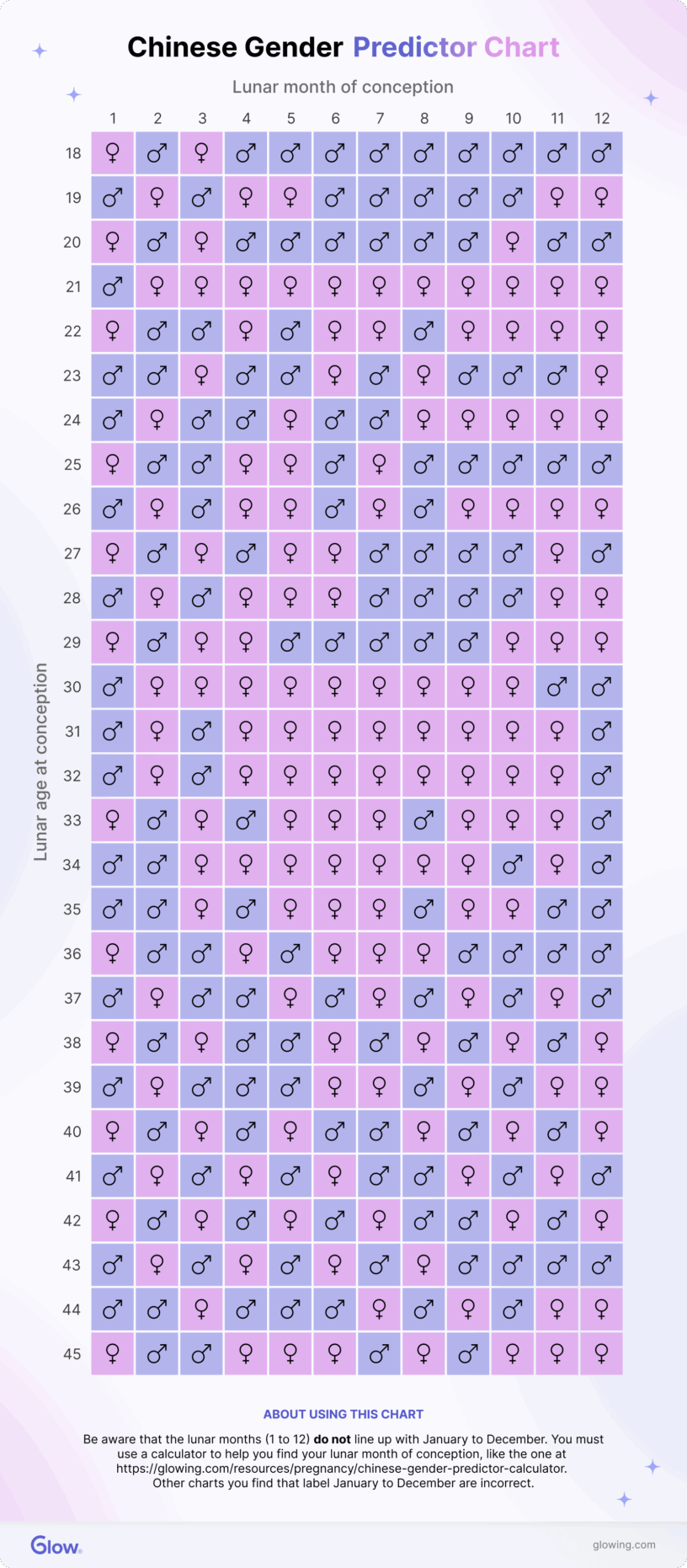FAQs about the Chinese Gender Predictor Chart and Calendar

- What is a Chinese gender predictor chart?
- How does the Chinese gender predictor chart work?
- Does the Chinese gender predictor chart really work?
- How can you actually find out your baby’s sex?
- Can your pregnancy symptoms predict your baby’s sex?
- What moms on Glow say about the Chinese gender predictor chart
What is a Chinese gender predictor chart?
The Chinese gender predictor chart, or Chinese gender calendar, is a tool that uses the Chinese lunar calendar to predict a baby’s sex.
The origins of this method are contested, but legend has it that the first chart like this was discovered in a royal Chinese tomb. The method is allegedly around 700 years old.
How does the Chinese gender predictor chart work?
This gender calendar uses the Chinese lunar calendar to determine your baby’s sex.
According to Chinese tradition, when you’re born, your lunar age, also known as your nominal age, starts at 1. You gain an extra year every Lunar New Year instead of on your birthday.
This means that your nominal age will usually be 1 or 2 years higher than your age according to the Gregorian (western) calendar, depending on what time of year you were born, what time of year it currently is, and what date Lunar New Year falls on that year.

The Chinese gender predictor chart takes your lunar age at the time of conception, as well as the month of conception, and uses that information to predict your baby’s sex.
Note that many Chinese gender charts you’ll see online are misleading, as they don’t inform you that you need to know both your lunar age and lunar conception date. To make things easier for you, our calculator takes your date of birth and your baby’s estimated due date and converts them into the information you need.
Our calculator’s estimate of your conception date is just an approximation
Since you may not be aware of exactly when you conceived, our calculator works backwards and estimates your conception date based on your estimated date of delivery (EDD). Remember that your EDD is also an estimate, not a fixed deadline. As such, no one—not even your doctor—can use it to compute your conception date with complete accuracy.
Does the Chinese gender predictor chart really work?
While many claim that the Chinese gender predictor chart is 93%–99% accurate, there’s no evidence that it really works or that your lunar age influences your baby’s sex at all. 1 Ultimately, this belief is a piece of folklore—fun, but not a scientifically based method.
Like all non-scientific methods for predicting your baby’s sex, such as the nub theory, the Chinese gender predictor isn’t a reliable way to determine whether you’re having a boy or a girl.
Is the Chinese gender predictor chart ever right?
Many moms swear by the Chinese gender predictor. However, in reality, it has a 50-50 chance of being accurate, the same as just guessing yourself!
What’s more, not all Chinese gender predictor charts are the same. As mentioned, many of the other charts you’ll see online aren’t even based on the lunar calendar at all, and you might get different sex predictions from different charts.
Should you use a Chinese gender predictor chart?
While the Chinese gender predictor is not a reliable way of finding out your baby’s sex, there’s no harm in trying it out for fun. Just don’t take the results too seriously or use them to make big decisions, like choosing your baby’s name or picking which baby clothes to buy.
How can you actually find out your baby’s sex?
Instead of relying on old wives’ tales, there are ways to find out your baby’s sex that are backed by science.
Let’s check out some of the more legit methods for determining whether you’re having a boy or a girl.
Mid-pregnancy ultrasound
Most parents who want to find out their baby’s sex have to wait until the mid-pregnancy (second trimester) ultrasound, also known as the 20-week ultrasound. As the name suggests, it’s often performed during week 20 of pregnancy, but you can get it at any point when you’re between 18 weeks and 22 weeks pregnant.
Many parents (incorrectly) refer to it as the “gender scan,” as it’s when many parents first find out their baby’s gender (or, technically, their baby’s sex).
How does the mid-pregnancy ultrasound determine your baby’s sex?
While the anatomy scan is primarily meant to check for abnormalities with your uterus or your baby, your ultrasound technician (sonographer) can also look for differences in the gender scan that determine whether you’re expecting a boy or a girl.
If your baby is in the right position, your sonographer will be able to see your baby’s genitals and can let you know whether you’re having a boy or a girl (if you want to know, that is).
This is a far more accurate way of determining your baby’s sex than the Chinese gender predictor, but it still isn’t foolproof. If your baby is positioned in a way that obscures the genitals (legs crossed, etc.), the sonographer might be unable to tell his sex. The same might be true if you’re overweight, carrying multiples, or experiencing gas or pregnancy-induced bloating, all of which can make the ultrasound picture fuzzier than it otherwise would be.
Other ways to determine your baby’s sex
Your mid-pregnancy ultrasound isn’t the only reliable means of determining your baby’s sex. You can also find out whether you’re carrying a boy or a girl via:
- Non-invasive prenatal testing (NIPT): With this blood test, your doctor can analyze fetal DNA in your blood. This test could let you find out your baby’s sex as early as the first trimester of your pregnancy, from when you’re around 10 weeks pregnant. 2
- Chorionic villus sampling (CVS): This optional genetic test, usually performed between 10 and 13 weeks of pregnancy, mainly looks for chromosomal abnormalities. However, it also lets you learn your baby’s sex. 3
- Amniocentesis: Your doctor will extract fluid from your amniotic sac (the bag of liquid that encases your baby) for genetic analysis, usually when you’re between 15 weeks and 20 weeks pregnant. The test will also be able to tell you your baby’s sex. 4
These tests are largely safe, but they aren’t completely risk-free (unlike the anatomy scan), so your doctor won’t order them just to let you find out whether you’re having a boy or girl. If they recommend them for other reasons, though, you can treat the opportunity to find out early as a nice bonus.
Can your pregnancy symptoms predict your baby’s sex?
You may have heard that certain pregnancy symptoms can be signs of having a boy or a girl, like that having heartburn means you’re having a girl or craving salty snacks means you’ve got a boy on board.
Unfortunately, there’s no scientific evidence for the vast majority of these beliefs, with just a few (partial) exceptions:
- Severe morning sickness: Many women have to deal with morning sickness (nausea) during pregnancy. Some expecting moms get a severe form of it called hyperemesis gravidarum, which results in constant vomiting and often requires medical attention. There’s some research that suggests women carrying female fetuses are more likely to have this condition. 5
- Pregnancy brain: Constant forgetfulness or brain fog is par for the course for many expecting moms, and pregnancy brain can start as early as the first trimester. There is research that seems to show a link between carrying a girl and performing more poorly on memory tests. However, these findings come from small studies. 5
- Food aversions: If the smell of cooking meat sends you running to the bathroom, know that you aren’t the first to contend with food aversions during pregnancy. Some research suggests that you’re more likely to experience food aversions if you’re carrying a boy. 6
Keep in mind that while there may be correlations between certain pregnancy symptoms and your baby’s sex, they’re exactly that—slight correlations, not guarantees—and the research on this is limited. Your symptoms aren’t a reliable way of finding out whether you’re carrying a boy or a girl.
What moms on Glow say about the Chinese gender predictor chart
You aren’t the first mom to be curious about the Chinese gender predictor chart. Other moms shared their own stories with the chart in Glow’s community:
- “Spot on with both my kids boy and girl, unsure about this one though will see!”
- “Mine was correct for my two kids. Not sure if it’s correct for this third baby yet.”
- “We did it for Every single person in my family and it was correct.”
- “says i’m having a boy but i’m most definitely having a girl :-)”
- “Told me all 3 of my girls, were going to be boys lol”
- “It was only correct for 1 of 3″
Stories taken from these threads on Glow’s message boards:
- “chinese gender calendar ?”
- “Has anyone used the Chinese gender calendar and it’s prediction be correct?”
To reiterate, the Chinese gender predictor chart should only be used for entertainment purposes. While it can’t predict your baby’s sex any better than a coin toss, it can still be fun, and it’s a great way to get excited about your future baby.
Article Sources
- American Journal of Obstetrics & Gynecology. "568: The Chinese birth calendar for prediction of gender - fact or fiction?" Retrieved August 6, 2025.
- MedlinePlus. "What is noninvasive prenatal testing (NIPT) and what disorders can it screen for?" Retrieved August 6, 2025.
- MedlinePlus. "Chorionic Villus Sampling (CVS)" Retrieved August 6, 2025.
- MedlinePlus. "Amniocentesis (amniotic fluid test)" Retrieved August 6, 2025.
- NeuroReport. "Selective and persistent effect of foetal sex on cognition in pregnant women" Retrieved August 6, 2025.
- Physiology & Behavior. "Disgust in pregnancy and fetus sex—Longitudinal study" Retrieved August 6, 2025.





